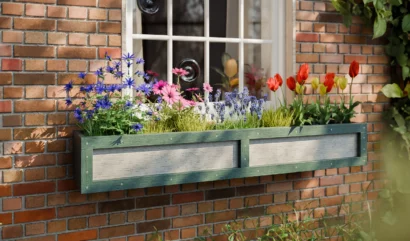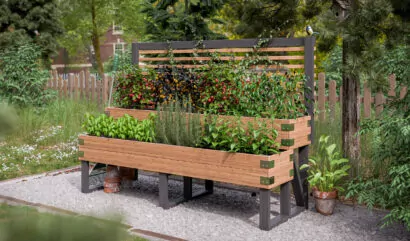
3×1 Window Planter Box Plans
Crafted from sturdy lumber with drainage holes and a secure mounting system, this decorative box adds natural beauty while providing the perfect environment for growing flowers, herbs, or small plants.

4×1 Window Planter Box Plans
Create a handcrafted garden accent perfect for flowers or herbs, with easy-to-follow plans suitable for any skill level and customizable finish options.

32×32 Raised Garden Bed Plans Walk In Enclosed
Create a thriving garden sanctuary that offers ample space for diverse plant varieties while keeping your harvest protected from wildlife.

2×8 Raised Herb Planter Plans
This sturdy outdoor structure enables comfortable cultivation of vegetables and herbs while accommodating mobility needs and promoting healthy root development.

DIY 2×6 Elevated Raised Garden Bed Plans
The elevated design prevents soil compaction and deters unwanted garden visitors while offering versatile growing space for your favorite plants.

2×2 Raised Planter Box Plans
The elevated design reduces back strain while gardening and provides optimal root growth conditions for your plants to thrive with better nutrient absorption.

2×3 Tiered Planter Box Plans
This ergonomically designed planter enables comfortable gardening while protecting your herbs, vegetables, and flowers from ground-dwelling pests.

4×8 DIY Raised Planter Box Plans
This elevated garden bed promotes inclusive gardening with its deep structure perfect for root vegetables and berries, while minimizing physical strain through its accessible height.

8×16 Raised Garden Bed Plans Walk In Enclosed
A durable and spacious planting solution that shields your flourishing garden from wildlife while providing ample room for diverse botanical cultivation.

DIY 16×32 Enclosed Raised Garden Bed Plans with Deer Fence
Experience abundant harvests in a spacious, durable planting area that keeps your vegetables, herbs, and flowers safe from wildlife while providing optimal growing conditions.

DIY Tiered Raised Garden Bed Plans
This ergonomically designed raised garden bed reduces strain while gardening and naturally protects your plants from ground-level pests.

Raised Garden Planter with Trellis Plans
Our durable raised planter combines ergonomic design with enhanced soil conditions, creating a versatile growing environment for both shallow and deep-rooted plants.

Raised Garden Planter Plans
Transform your idle garden space into a thriving oasis with this ergonomic raised planter that makes gardening comfortable while providing optimal depth for healthy root development.

U Shaped Raised Garden Bed Plans
Our elegantly engineered design creates distinct growing zones for varied plant needs while ensuring effortless maintenance and visual appeal in your outdoor space.

DIY 2 Tier Elevated Raised Garden Bed Plans
This ergonomically designed planter stands at a back-friendly height with sturdy legs, featuring dedicated zones for herbs, veggies, and climbing plants while keeping garden pests at bay.

DIY 3×8 Raised Garden Bed Plans Simple
Transform any underutilized garden corner into a thriving oasis with this deep, ergonomically designed planter that makes gardening comfortable while promoting healthy root growth.

DIY Elevated Raised Garden Bed Plans Waist High
Elevating your garden protects soil quality and deters unwanted visitors while offering ample space for a variety of plants, with customization options for climbing varieties.

DIY 3×10 Raised Garden Bed Plans with Bench
Cultivate a stunning blend of vegetables and flowers in this deep, spacious planter featuring a built-in storage solution for your gardening essentials.

DIY Tiered Raised Garden Bed Plans Vertical Modular
This versatile planting solution maximizes vertical space, perfect for creating a stunning display of shallow-rooted herbs, flowers, and vegetables in smaller gardens.

DIY 3×6 Raised Garden Bed Plans with Trellis
Transform your outdoor space into a thriving garden oasis with this elevated planting solution that's perfect for both novice and experienced gardeners seeking a blend of functionality and style.

4×8 Raised Garden Bed Plans Simple
Create a comfortable gardening experience with the elevated height that minimizes physical strain and accommodates deep-rooted plants for bountiful harvests.

DIY L Shaped Tiered Raised Garden Bed Plans
Transform your limited outdoor space into a flourishing garden sanctuary with our two-tiered raised bed system, offering 27 square feet of versatile growing area for your favorite herbs, vegetables, and flowers.

DIY 6×6 L Shaped Raised Garden Bed Plans Corner
The generous depth of 1 foot and 4½ inches makes this garden bed ideal for deep-rooted plants like tomatoes and blueberries, ensuring optimal growth and healthy root development.

DIY Raised Garden Bed Plans with Trellis Vertical
This all-season, maintenance-free garden bed offers 18 square feet of space and stands at 1'4.5" tall, perfect for deep-rooted plants and hanging planters.

DIY 3×8 Raised Garden Bed Plans with Trellis
Discover the perfect balance of form and function with our cedar garden bed, offering 24 square feet of growing space and an integrated full-length trellis for optimal vertical gardening.
